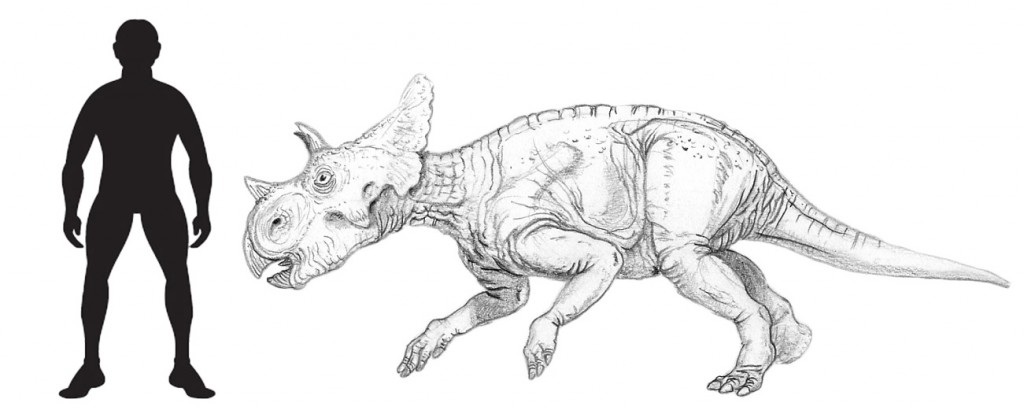Potential New Species of Horned Dinosaur Reported
Potential New Addition to the Ceratopsidae Family
Everything Dinosaur has received reports that scientists from the Museum of the Rockies (Bozeman, Montana), may have discovered a new species of horned dinosaur (Ceratopsidae family). The fossils including elements of the skull were originally found during fieldwork on the Judith River Formation back in 2012, but it was not until this week that researchers realised that the bones could represent a new species of horned dinosaur.
Horned Dinosaur
The Judith River Formation, part of the Judith River Group, is famous for its vertebrate fossils and a number of dinosaur genera have been described from the various sub-divisions that make up the Judith River Formation, although, as far as we at Everything Dinosaur there has never been any sauropod fossils associated with this particular geological feature.
Numerous ornithischian and theropod dinosaur fossils have been found, although a number of genera that have been named are based on very fragmentary remains, a consequence of this part of Montana being first explored during the “Bone Wars” of the late 19th century by scientists such as Edward Drinker Cope.
Eighty-five Percent of One Individual Dinosaur
As the fossils, which represent about eighty-five percent of one individual, were found very close to the Careless Creek Ranch site where the first fossilised remains of the small horned dinosaur known as Avaceratops (A. lammersi), were discovered back in 1981, it was thought that the bones represented another specimen of Avaceratops. However, as researchers from the Museum of the Rockies removed the fossils from their protective plaster and burlap jackets it was noted that the skull morphology was somewhat distinctive and different from that seen in the Avaceratops holotype.
In addition, this specimen seemed to lack a nasal horn. This data has led the researchers to speculate that this could be a brand new species of horned dinosaur.
Commenting on the work carried out so far, John Scannella, Palaeontology Collections Manager for the Museum explained:
“What’s important is that before a new dinosaur species is named that the bones that are supposed to belong to this new species of dinosaur are closely studied by palaeontologists and compared to other specimens that might look similar.”
An Illustration of the Dinosaur Called Avaceratops (A. lammersi)
Picture credit: Everything Dinosaur
Is This a New Species of Ceratopsian?
If the fossil represents a new species then it can possibly help palaeontologists to learn more about the radiation of the Ceratopsidae that took place during the Early to Middle Campanian faunal stage (around 79 to 77 million years ago). If the fossils turn out to be another example of an Avaceratops, than ironically they could have a far greater significance. The relationship between Avaceratops and other members of the horned dinosaur family tree is not clear (phylogeny).
For models and replicas of Avaceratops (whilst stocks last) and other horned dinosaurs: Beasts of the Mesozoic Models.
Avaceratops is regarded as a basal member of the centrosaurine dinosaurs, but this position has been debated. In addition, the actual size of this dinosaur remains uncertain. The holotype material has been regarded as representing a sub-adult, even a juvenile specimen. In Everything Dinosaur’s illustration we show Avaceratops as being relatively small for a Late Cretaceous member of the Ceratopsidae. However, other researchers who have looked at more recent fossil finds suggest that this dinosaur could have reached lengths of over four metres and weighed in excess of one tonne.
If these new fossils do indeed represent another Avaceratops, then with eighty-five percent of the skeleton to study, palaeontologists might learn a lot more about how Avaceratops grew and where it fits into the horned dinosaur family.
Potentially a New Horned Dinosaur
A spokesperson from Everything Dinosaur stated:
“The problem with horned dinosaurs is that they seem to have changed substantially as they grew up and matured. As features such as horns and neck frills change, then it can take a very long time to determine whether this is really a new species or just a specimen at a younger or older growth stage than the fossils of an already described species.”
Avaceratops has been very much one of Everything Dinosaur’s “dinosaurs of the week” this week. During a school visit, we met a young girl called Ava and we explained all about the dinosaur that shares her name. We even sent over a picture of Avaceratops so the class could see what we think this dinosaur looked like. Avaceratops was named after Ava Cole, the wife of Eddie Cole who found the first fossils of this herbivorous dinosaur.


